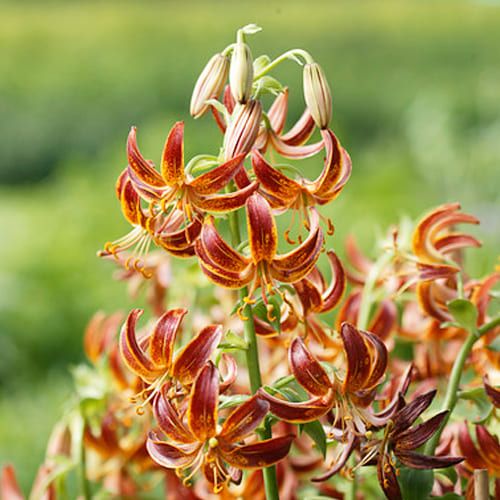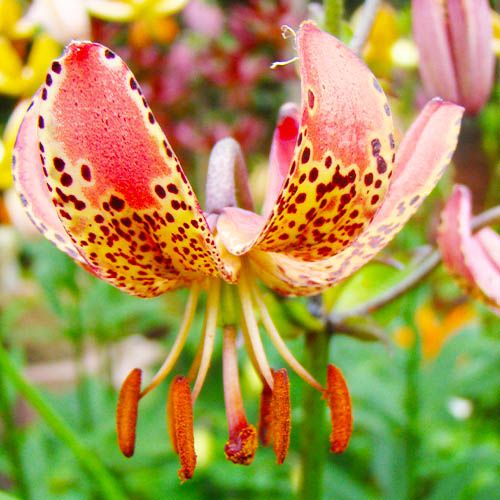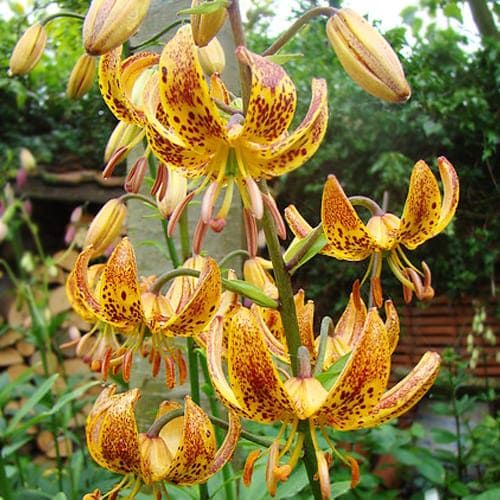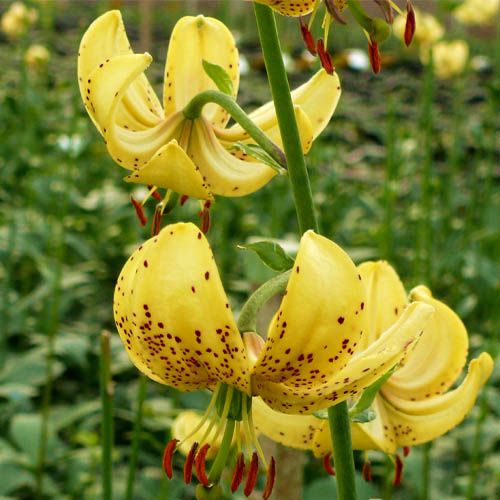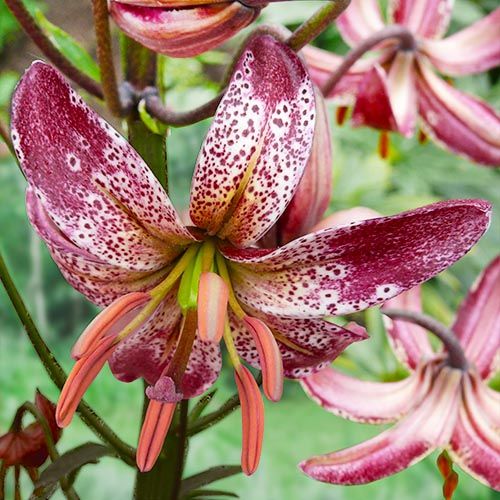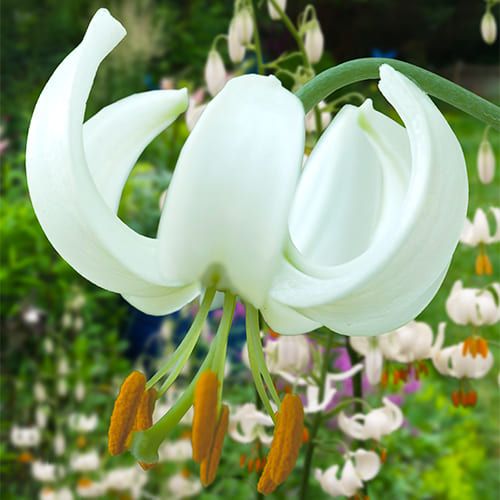
Martagon Lilies
Martagon Lilies
Last Reviews
The Complete Guide to Martagon Lilies: Planting, Care, and More
Martagon lilies are stunning plants with drooping petals and brightly colored blooms that make a statement in any garden. Heres everything you need to know about planting, caring for, and enjoying these unique flowers.
Planting Martagon Lilies
- Martagon lilies prefer slightly acidic, well-draining soil with a pH between 5.5 and 6.5. They grow best in a location that receives full to partial sun and provides plenty of air circulation. If youre planting martagon lilies in the fall, do so at least six weeks before the first frost. This will allow the roots to establish themselves.
- Choose a location: Choose a location with well-drained soil that receives full or partial sun. Martagon lilies prefer an acidic soil pH.
- Prepare the soil: Amend the soil with compost or peat moss to improve drainage and add nutrients. Dig a hole about 6-8 inches deep and mix in some bone meal or other organic fertilizer.
- Plant the bulbs: Place the bulbs in the hole, with the pointed end facing up, and cover with soil. Space the bulbs 12-18 inches apart. Water the bulbs immediately after planting.
- Mulch: Cover the soil around the bulbs with a layer of mulch to retain moisture and prevent weeds.
Caring for Martagon Lilies
Martagon lilies are relatively easy to care for and require minimal maintenance once established. Here are some tips for keeping your martagon lilies healthy and beautiful.
Watering: Water your martagon lilies regularly, keeping the soil moist but not waterlogged. Avoid overhead watering, which promotes disease.
Fertilizing: Treat your martagon lilies in the spring with a slow-release fertilizer or balanced organic fertilizer. Avoid fertilizing after mid-summer, as this can promote late-season growth vulnerable to frost damage.
Pruning: Remove spent flowers as soon as they fade, but leave the stem and foliage intact. This will allow the plant to redirect energy into bulb development rather than seed production.
Winter care: In areas with cold winters, mulch the soil around the bulbs with a layer of straw or leaves to protect them from freezing temperatures.
Propagation
Martagon lilies can be propagated through division, which should be done in the fall after the foliage has died back. Dig up the bulbs, separate the offsets, and replant them at the same depth as the original bulbs.
Pests and Diseases
Martagon lilies are relatively pest and disease-resistant, but they can be susceptible to some problems. Here are some common issues to watch out for:
Red Lily Beetle: This pest can defoliate the plant and weaken it. Handpick and destroy beetles and larvae, or use an insecticide labeled for lilies.
Botrytis Blight: This fungal disease causes brown spots on the leaves and flowers. Remove infected plant material and avoid overhead watering to prevent spread.
Aphids: These small insects can cause distorted growth and sticky residue. Spray with insecticidal soap or neem oil to control infestations.
Martagon Lilies 101: Understanding the Different Types
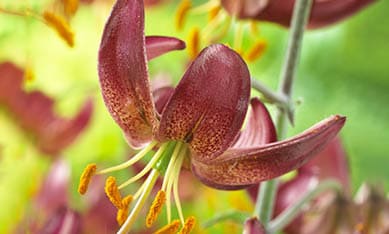
Martagon lilies are an attractive and unique type of lily recognized by their downward-facing flowers and whorled leaves. They come in a variety of types and colors, each with unique characteristics. Here are some of the different types of Martagon lilies and what sets them apart:
1.Lilium martagon: This is the classic Martagon lily, also known as the Turks cap lily. It has deep purple-red flowers with dark spots, and it can grow up to 5 feet tall.
2.Lilium martagon album: This is a white-flowered version of the Lilium martagon. It has pure white flowers with no spots, and it can grow up to 4 feet tall.
3.Lilium martagon Claude Shride: This variety of Martagon lily has bright orange-red flowers with dark spots. It can grow up to 4 feet tall.
4.Lilium martagon Sunny Morning: This Martagon lily has soft yellow flowers with pinkish hue and brown spots. It can grow up to 4 feet tall.
5.Lilium martagon Mrs. R.O. Backhouse: This variety of Martagon lily has soft pink flowers with dark spots. It can grow up to 4 feet tall.
6.Lilium martagon Russian Morning: This type of Martagon lily has deep red flowers with dark spots. It can grow up to 5 feet tall.
7.Lilium martagon Manitoba Morning: This variety of Martagon lily has pink flowers with yellow centers and brown spots. It can grow up to 5 feet tall.
Planting Martagon Lilies: When, Where, and How
Before the first frost, in the fall, usually in September or October, martagon lily bulbs are planted. They are an excellent choice for regions that get moderate amounts of sunlight all day because they prefer well-drained soil and some shade. Martagon lily bulbs should be planted at a depth of roughly 6 inches and separated by a distance of roughly 12 inches when laying out. You can ensure that your martagon lilies flourish in your garden by adhering to these rules.
Martagon Lily Care: Watering, Fertilizing, and Maintenance Tips
Martagon lilies are relatively low maintenance and require little attention once they are established in your garden. They prefer well-drained soil that is kept consistently moist but not waterlogged. In terms of fertilization, its recommended to apply a balanced fertilizer in the spring before the lilies bloom. Additionally, removing any dead or damaged foliage throughout the year will keep your martagon lilies looking their best.
Propagating Martagon Lilies: How to Expand Your Collection
Propagating martagon lilies is an excellent way to grow your collection if youre interested in doing so. Bulb division is one of the simplest methods of propagating martagon lilies. Digging up a mature cluster of martagon lilies and removing the bulbs for planting elsewhere is required. When dividing the bulbs, it is crucial to wait until they are dormant, which usually happens in late summer. You may quickly increase your martagon lily collection by using this technique without buying extra bulbs.
Moving Martagon Lilies: Tips for Transplanting and Dividing
There are a few things to consider if you need to relocate your martagon lilies or divide them for propagation. Prior to transplanting or dividing the lilies, it is crucial to wait until they are dormant to reduce shock or harm. Digging up the entire bulb is required when transplanting martagon lilies to protect the roots. In order to maintain proper growth, its also crucial to ensure that each division of a bulb has at least one healthy stem and root system.












